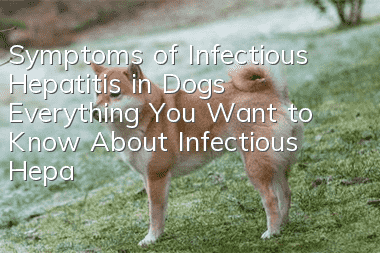Symptoms of Infectious Hepatitis in Dogs Everything You Want to Know About Infectious Hepatitis

The etiology and epidemiology of canine infectious hepatitis
1. Pathogen: canine type I adenovirus, also known as canine infectious hepatitis virus, belongs to the family Adenoviridae. Mammalian adenovirus, double-stranded DNA virus. It is mainly transmitted through the digestive tract, but can also be transmitted vertically.
2. Source of infection: Affected dogs and virus-carrying dogs detoxify through secretions and excretions such as tears, saliva, feces and urine, and contaminate the surrounding environment, feed and utensils, etc.
3. Susceptible animals are mainly dogs and foxes. There is no difference in breed, age and gender, but most are puppies under 1 year old. Puppies have the highest morbidity and mortality after weaning, and adult dogs generally have latent infection. Recovered dogs are immune for life, but the virus can survive in the kidneys and be detoxified in the urine for 6 to 9 months. It is an important source of infection in healthy dogs.
Symptoms of canine infectious hepatitis
The incubation period of this disease is 6 to 9 days. In some of the most acute puppy diseases, the body temperature is elevated at the beginning and the spirit is highly depressed. There are usually no other symptoms. Symptoms may lead to death within 1 to 2 days.
1. Cold-like symptoms: Most dog diseases initially resemble acute colds, with elevated body temperature, depression, loss of appetite, and a small amount of serous or mucus secretions from the eyes and nose, but no cough symptoms.
2. Gastrointestinal symptoms: Vomiting, constipation or bloody diarrhea are the main symptoms of this disease. Bleeding spots or bleeding spots on the gums are important symptoms of this disease.
3. Other symptoms: The abdomen of many affected dogs is enlarged. A large amount of cool, light red liquid can be discharged by thoracoabdominal puncture, and the xiphoid cartilage area is sensitive and painful when touched. Many affected dogs develop proteinuria. The cornea of one or both eyes of some dogs becomes cloudy during the recovery period of the disease and seems to be covered by a light blue film, which is called "hepatitis blue eye". The cornea turns clear after a few days.
How to diagnose canine infectious hepatitis
This disease should be suspected based on clinical symptoms, but pay attention to canine distemper, parvovirus enteritis, cold or traumatic corneal opacity, etc. Make a distinction. Compared with canine distemper, this disease has no respiratory and nervous system infection symptoms; compared with parvovirus enteritis, both have symptoms of bloody diarrhea, but parvovirus infection does not show gum bleeding spots, spots, or abdominal distension; Compared with a cold, there are no symptoms of respiratory tract infection, but no symptoms of digestive tract infection; compared with traumatic corneal opacity, the cornea surface of "hepatitis blue eye" is smooth and has no traces of trauma, while dogs with simple traumatic corneal opacity have no body temperature. Systemic symptoms such as elevated blood pressure and digestive tract infection.
For dead dogs, you can see liver enlargement, gallbladder wall edema, small intestinal bleeding, and a large amount of cool, light red fluid accumulating in the chest and abdominal cavity. Histologically, the liver parenchyma showed varying degrees of degeneration, and there were nuclear inclusions in hepatocytes and sinusoidal endothelial cells. There is currently no rapid clinical diagnostic test strip for this disease, butThere are many laboratory diagnostic methods, such as microcoagulation and hemagglutination inhibition tests, fluorescent antibody tests, and polymerase chain reaction (PCR) methods.
How to treat canine infectious hepatitis
Use high-dose hyperimmune serum against canine adenovirus type 1 or 2 in the early stage, while paying attention to liver protection and control of bleeding symptoms.
As liver protection measures, try Ganyanling (Sandougen) injection, inosine injection, VB6, etc. Because this disease leads to insufficient synthesis of coagulation factors in the liver and a significant decrease in platelets, conventional hemostatic drugs are often ineffective. It is best to promptly transfuse blood or plasma to replenish coagulation factors and platelets, and at the same time use antiviral drugs, antibacterial drugs, hemostatic drugs, and vitamins. Wait for treatment.
【Prognosis】
Because the virus causes damage to the liver and small blood vessel endothelial cells, it is generally difficult to control bleeding symptoms in dogs using conventional drugs. In the end, most sick puppies die of severe anemia and dehydration. Adult dogs can usually tolerate it, and most recover within 2 weeks and develop strong immunity.
【Prevention】
Rehabilitation dogs are able to detoxify through their urine over time and should avoid being housed with healthy dogs. For susceptible dogs, domestic or imported canine vaccine series can be used for immunization. See Canine Distemper Prevention.
- Is it better for Dogo dogs to have their ears erect or cropped? A case of Dogo dog’s ear erection surgery will tell you
- What do dogs eat to protect their stomach? It is important to protect their stomach and treat gastrointestinal diseases in dogs.
- How to tell if your dog is fat? Is your dog overweight?
- Will your dog catch a cold if you blow the air conditioner? What should you do if your dog catches a cold if you blow the air conditioner?
- What should you pay attention to when your dog drinks water? Don’t be careless when it comes to your dog’s drinking water.
- The dog's mouth bites and shakes. Why does the dog's mouth occasionally shake and bite?
- How to cut a dog's hair? Do you know how to cut a dog's hair correctly?
- Can dogs eat raw eggs? Why can’t dogs eat egg whites?
- Common Dog Problems in Summer How to Deal with Different Dog Problems
- How to keep dogs away from skin diseases. If you do this, will you see if your dog will still be infected with skin diseases?



